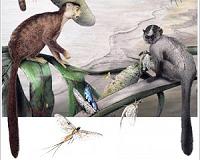| . |  |
. |
Denver CO (SPX) Nov 02, 2010 The giant dragonflies of ancient Earth with wingspans of up to 70 centimeters (28 inches) are generally attributed to higher oxygen atmospheric levels in the atmosphere in the past. New experiments in raising modern insects in various oxygen-enriched atmospheres have confirmed that dragonflies grow bigger with more oxygen, or hyperoxia. However, not all insects were larger when oxygen was higher in the past. For instance, the largest cockroaches ever are skittering around today. The question becomes how and why do different groups respond to changes in atmospheric oxygen. The secrets to why these changes happened may be in the hollow tracheal tubes insects use to breathe. Getting a better handle on those changes in modern insects could make it possible to use fossilized insects as proxies for ancient oxygen levels. "Our main interest is in how paleo-oxygen levels would have influenced the evolution of insects," said John VandenBrooks of Arizona State University in Tempe. To do that they decided to look at the plasticity of modern insects raised in different oxygen concentrations. The team raised cockroaches, dragonflies, grasshoppers, meal worms, beetles and other insects in atmospheres containing different amounts of oxygen to see if there were any effects. One result was that dragonflies grew faster into bigger adults in hyperoxia. However, cockroaches grew slower and did not become larger adults. In all, ten out of twelve kinds of insects studied decreased in size in lower oxygen atmospheres. But there were varied responses when they were placed into an enriched oxygen atmosphere. VandenBrooks will be presenting the results of the work on Monday, Nov. 1 at the annual meeting of the Geological Society of America in Denver. "The dragonflies were the most challenging of the insects to raise," said VandenBrooks because, among other things, there is no such thing as dragonfly chow. As juveniles they need to hunt live prey and in fact undergraduate students Elyse Munoz and Michael Weed working with Dr. VandenBrooks had to resort to hand feeding the dragonflies daily. "Dragonflies are notoriously difficult to rear," said VandenBrooks. "We are one of the only groups to successfully rear them to adulthood under laboratory conditions." Once they had worked that out, however, they raised three sets of 75 dragonflies in atmospheres containing 12 percent (the lowest oxygen has been in the past), 21 percent (like modern Earth's atmosphere) and 31 percent oxygen (the highest oxygen has been). Cockroaches, as anyone who has fought them at home knows, are much easier to rear. That enabled the researchers to raise seven groups of 100 roaches in seven different atmospheres ranging from 12 percent to 40 percent oxygen mimicking the range of paleo-oxygen levels. Cockroaches took about twice as long to develop in high oxygen levels. "It is the exact opposite of what we expected," said VandenBrooks. One possibility is that the hyperoxic reared roaches stayed in their larval stage longer, perhaps waiting for their environment to change to a lower, maybe less stressful oxygen level. This surprising result prompted the researchers to take a closer look at the breathing apparatus of roaches - their tracheal tubes. These are essentially hollow tubes in an insect's body that allow gaseous oxygen to enter directly into the insect tissues. VandenBrooks and his team took their hyperoxic reared roaches to Argonne National Lab's x-ray synchrontron imaging facility to get a closer look at the tracheal tubes. The x-ray synchrontron is particularly good at resolving the edges where things of different phases meet - like solids on liquids or gas on solids. That's just what the inside of a tracheal tube is. What they found was that the tracheal tubes of hyperoxic reared roaches were smaller than those in lower oxygen atmospheres. That decrease in tube size with no increase in the overall body size would allow the roaches to possibly invest more in tissues used for other vital functions other than breathing - like eating or reproducing. The roaches reared in hypoxia (lower oxygen) would have to trade off their investment in these other tissues in order to breathe. The next step, said VandenBrooks, will be to look closely at the tracheal tubes of insects fossilized in amber to see what they might say about oxygen levels at various times in the past. These might possibly serve as a proxy for paleo-oxygen levels. "There have been a lot of hypotheses about the impact of oxygen on evolution of animals, but nobody has really tested them," said VandenBrooks. "So we have used a two-pronged approach: 1) study modern insects in varying oxygen levels and 2) study fossil insects and understand changes in the past in light of these results." Paper No. 77-5: ATMOSPHERIC OXYGEN AND THE EVOLUTION OF INSECT GIGANTISM
Share This Article With Planet Earth
Related Links Geological Society of America Explore The Early Earth at TerraDaily.com
 Fossils Suggest Earliest Anthropoids Colonized Africa
Fossils Suggest Earliest Anthropoids Colonized AfricaPittsburgh, PA (SPX) Nov 02, 2010 in the journal Nature, a new discovery described by a team of international scientists, including Carnegie Museum of Natural History paleontologist Christopher Beard, suggests that anthropoids-the primate group that includes humans, apes, and monkeys-"colonized" Africa, rather than originally evolving in Africa as has been widely accepted. According to this paper, what is exceptional about ... read more |
|
| The content herein, unless otherwise known to be public domain, are Copyright 1995-2010 - SpaceDaily. AFP and UPI Wire Stories are copyright Agence France-Presse and United Press International. ESA Portal Reports are copyright European Space Agency. All NASA sourced material is public domain. Additional copyrights may apply in whole or part to other bona fide parties. Advertising does not imply endorsement,agreement or approval of any opinions, statements or information provided by SpaceDaily on any Web page published or hosted by SpaceDaily. Privacy Statement |